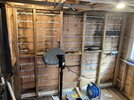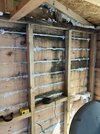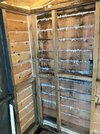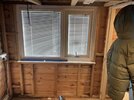- Joined
- 31 Mar 2013
- Messages
- 10
- Reaction score
- 0
- Country

Hi all
Hoping someone can help with my current predicament. Just to be clear I am not sure on what to do and have scoured the internet for some advice. Hoping someone can tell me whether I am in the right track or I am crazy and should pull it down.
I have a log lap shed which was built as an office by the previous owner of the house. To cut a long story short it leaks on 3 walls and the tongue and groove boards at the end are either water damaged or rotting. It all started off as noticing that the plasterboard was wet in one corner.
My not so clear plan is to either get someone in or do the following myself
I have pulled the rotten floor board and the base only has visqueen on the bottom of the joists and no where else. Insulation ( polystyrene) sat on the concrete floor which were soaked through
My thoughts here are
I seem to be going round in circles and so would welcome any advice
Hoping someone can help with my current predicament. Just to be clear I am not sure on what to do and have scoured the internet for some advice. Hoping someone can tell me whether I am in the right track or I am crazy and should pull it down.
I have a log lap shed which was built as an office by the previous owner of the house. To cut a long story short it leaks on 3 walls and the tongue and groove boards at the end are either water damaged or rotting. It all started off as noticing that the plasterboard was wet in one corner.
My not so clear plan is to either get someone in or do the following myself
- Refit cladding
- Paint cladding walls with something like ronseal water seal
- Seal cladding inside and out with waterproof sealant ( I already started this but noticed water was still coming in)
- Add a breathable membrane over the inside so it covers the walls
- Install pir insulation
- Cover with a vapour barrier
- Fit plasterboard
I have pulled the rotten floor board and the base only has visqueen on the bottom of the joists and no where else. Insulation ( polystyrene) sat on the concrete floor which were soaked through
My thoughts here are
- if floor joists are rotted, fit new ones parallel to existing ones
- Cut Dpc sheet to size and fit into gaps?
- Fit pir insulation onto membrane
- Maybe use marine plywood to sit on top
- Fit a dpc skirt around bottom of shed so that no splashing or rain water can hit the concrete floor.
I seem to be going round in circles and so would welcome any advice






